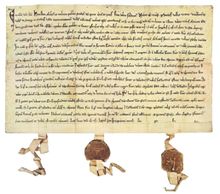
Federal Charter of 1291
Encyclopedia

Canton (subnational entity)
A canton is a type of administrative division of a country. In general, cantons are relatively small in terms of area and population when compared to other administrative divisions such as counties, departments or provinces. Internationally the best-known cantons, and the most politically...
in what is now central Switzerland
Switzerland
Switzerland name of one of the Swiss cantons. ; ; ; or ), in its full name the Swiss Confederation , is a federal republic consisting of 26 cantons, with Bern as the seat of the federal authorities. The country is situated in Western Europe,Or Central Europe depending on the definition....
. It is dated in early August, 1291 and initiates the current August 1 national Swiss holiday. This agreement cites a previous (lost) similar pact. It is actually exhibited at the archives of the Swiss Charters of Confederation in Schwyz
Schwyz
The town of is the capital of the canton of Schwyz in Switzerland.The Federal Charter of 1291 or Bundesbrief, the charter that eventually led to the foundation of Switzerland, can be seen at the Bundesbriefmuseum.-History of the toponym:...
.
This inaugural confederation grew through a long series of accessions to modern Switzerland. The Alliance was concluded between the people of the alpine
Swiss Alps
The Swiss Alps are the portion of the Alps mountain range that lies within Switzerland. Because of their central position within the entire Alpine range, they are also known as the Central Alps....
areas of Uri
Canton of Uri
Uri is one of the 26 cantons of Switzerland and a founding member of the Swiss Confederation. It is located in Central Switzerland. The canton's territory covers the valley of the Reuss River between Lake Lucerne and the St. Gotthard Pass. German is the primary language spoken in Uri...
, Schwyz
Canton of Schwyz
Schwyz is a canton in central Switzerland between the Alps in the south, Lake Lucerne in the east and Lake Zurich in the north, centered around and named after the town of Schwyz....
and Unterwalden
Unterwalden
Unterwalden is the old name of a forest-canton of the Old Swiss Confederacy in central Switzerland, south of Lake Lucerne, consisting of two valleys or Talschaften, now organized as two half-cantons, an upper part, Obwalden, and a lower part, Nidwalden.Unterwalden was one of the three participants...
(). The participants are referred to as conspirati and (synonymously) coniurati, traditionally translated in German as "Eidgenossen".
The charter was set up as a canon for judicature and defense purposes (only two of seven paragraphs address foreign dangers), probably prompted by the death of Rudolf I of Habsburg on 15 July 1291 to ensure legal certainty.
The authenticity of the letter used to be disputed as a supposed modern forgery. Most historians now agree that it is almost certainly a product of the 14th century.
In 1991, the parchment was radiocarbon dated
Radiocarbon dating
Radiocarbon dating is a radiometric dating method that uses the naturally occurring radioisotope carbon-14 to estimate the age of carbon-bearing materials up to about 58,000 to 62,000 years. Raw, i.e. uncalibrated, radiocarbon ages are usually reported in radiocarbon years "Before Present" ,...
to between 1252 and 1312 (with a certainty of 85%). The document is thus certainly not a late forgery tied to the emergence of the modern federal state in 1848. It should rather be seen in the context of chapter 15 of the Golden Bull of 1356
Golden Bull of 1356
The Golden Bull of 1356 was a decree issued by the Reichstag assembly in Nuremberg headed by the Luxembourg Emperor Charles IV that fixed, for a period of more than four hundred years, important aspects of the constitutional structure of the Holy Roman Empire...
, where Charles IV
Charles IV, Holy Roman Emperor
Charles IV , born Wenceslaus , was the second king of Bohemia from the House of Luxembourg, and the first king of Bohemia to also become Holy Roman Emperor....
outlawed any conjurationes, confederationes, and conspirationes, meaning in particular the city alliances (Städtebünde), but also other communal leagues that had sprung up through the communal movement in medieval Europe. It should be mentioned that it was very common to produce documents only when needed in this period; agreements were made by word of mouth (which is still a legal form of contract in Switzerland today), which means the date of any documents was subject to "moving" through time to meet the purpose of the document.
See also
- TagsatzungTagsatzungThe Swiss Tagsatzung was the legislative and executive council of the Swiss confederacy from the beginnings until the formation of the Swiss federal state in 1848. It was a meeting of delegates of the individual cantons...
- RütlischwurRütlischwurThe Rütlischwur is a legendary oath of the Old Swiss Confederacy, taken on the Rütli, a meadow above Lake Lucerne near Seelisberg. The oath is notably featured in the Wilhelm Tell drama of 1804 by Friedrich Schiller.-Early accounts:...
- Swiss National DaySwiss National DayThe Swiss National Day is the national holiday of Switzerland, set on 1 August. It is an official national holiday since 1994, although the day had been suggested for the celebration of the foundation of the Swiss Confederacy as early as 1889.-History:...
- Historiography of SwitzerlandHistoriography of SwitzerlandThe historiography of Switzerland is the study of the history of Switzerland. Up until the late twentieth century, it was largely shaped by the centuries-old traditional account of the founding of the Old Swiss Confederacy through the Federal Charter of 1291 as a defensive alliance of small...

